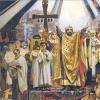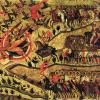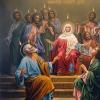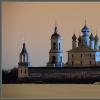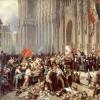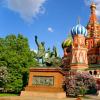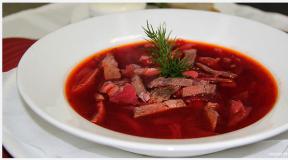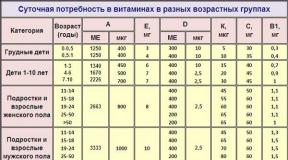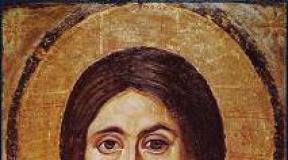1571 raid devlet girey. Khan Giray: biography. Girey dynasty. War and internal strife
On June 3, 1571, during the Great Crimean raid on Russian lands, the army of Khan Devlet Giray broke through to Moscow. The Tatars plundered and burned the capital of the Moscow kingdom, which burned out almost completely, only the Kremlin survived. Taking a lot of booty and a great full, the khan returned to the Crimea.
In the spring of 1571, Devlet Giray gathered a large army for a campaign against Russia. The number of Tatar armies of that time could only be indicated approximately, since the detachments of the steppes did not differ in special discipline and could at any time join the main horde or leave it. According to various estimates, from 60 to 120 thousand participated in this campaign, although the last figure indicated in the annals is considered exaggerated by historians.
The moment for the campaign was chosen very well - the main forces of the Russian kingdom at that moment were connected by the Livonian War. As a result, the "coastal governors" on the Oka had at their disposal no more than 6 thousand warriors.
Initially, the Crimean Khan was not at all going to go to Moscow, intending to limit himself to a raid on the Kozelsk places for robbery and capturing full. However, having received reports from defectors about the small number of Russian troops, Devlet-Girey changed his plans. His army bypassed the Serpukhov fortifications near the Oka from the west and, having crossed the Ugra, entered the flank of the small Russian border troops. After the defeat of the Russian avant-garde, the Tatars rushed to Moscow, threatening to cut off the retreat to the north for the small Russian troops. Not having the strength to stop the advance of the enemy, the governors retreated to the capital, where the surrounding population also fled. Meanwhile, Tsar Ivan IV himself left for Rostov.
Moving quickly, the khan approached Moscow on the shoulders of the retreating governors, ruining the camp near Kolomenskoye, which they had abandoned in a hurry. On June 3, 1571, Crimean detachments ravaged unprotected settlements and villages around Moscow, after which they set fire to the suburbs of the capital. Due to the strong wind, the fire quickly spread throughout the city. Driven by fire, the townspeople and refugees rushed to the northern gates of the capital. A crush arose in the gates and narrow streets, people "walked in three rows over each other's heads, and the upper ones crushed those who were under them."
The zemstvo army, instead of giving battle to the Tatars in the field or on the outskirts of the city, began to leave for the center of Moscow and, having mixed with the refugees, lost order; Governor Prince Belsky died during a fire, suffocating in the cellar of his house. Within three hours, Moscow burned to the ground. The fire was so strong that even the Tatars themselves were prevented from robbing in the suburbs.
The regiment of the voivode Mikhail Vorotynsky, who settled in the Kremlin, managed to repel all the Tatar attacks, and the khan did not dare to besiege the stone fortress, having heard about the approach of a large Russian army. The next day, the Tatars and Nogais with huge booty went along the Ryazan road to the steppe.
The number of dead and captured historians find it difficult to determine exactly: the numbers are from 60 to 150 thousand taken into slavery and from 10 to 80 thousand who died during the attack of the Tatars on Moscow. The terrible ruin of Moscow is evidenced by the papal legate Possevino, who in 1580 numbered no more than 30 thousand people, although back in 1520 there were 41,500 houses and at least 100 thousand inhabitants in Moscow.
Having won such an impressive victory, Devlet-Giray demanded that the Russian tsar give up Astrakhan and Kazan, threatening otherwise with a new campaign. Stunned by the defeat, Ivan the Terrible replied in a reply message that he agreed to transfer Astrakhan under Crimean control, but Kazan refused to return Gireyam. Confident in his military superiority, the khan did not make this “half-hearted” decision, which ultimately saved the Russian state from territorial losses.
Inspired by his success, Devlet Giray put forward a plan for the complete defeat and subjugation of the Russian state, which was supported by the Ottoman administration in Istanbul. And the very next year, a huge 100,000-strong Crimean-Turkish army again moved to Moscow. However, this time he was in for a stunning rout in the Battle of Molodi from the 25,000-strong Russian army under the command of voivode Mikhail Vorotynsky. This defeat nullified all the previous successes of the Crimean Khan.
THE POLICY OF DEVLET-GIREY I AND HIS SUCCESSORS
It was said above that several junior members of the Girey clan were constantly in Istanbul in case it was necessary to change the khan. So Sahib-Giray was also replaced. The sultan sent him a firman on a campaign to pacify the Circassians, and when the khan left the Crimea with an army, the sultan's prisoner, Devlet Giray, was landed in Gyozlev, rode to Bakhchisaray, where he published the Turkish letter of his appointment. The former khan who returned home was seized by the beys and strangled along with his closest relatives.
Devlet Giray I (1551 - 1577) remained on the throne for such a long time, apparently, thanks to his almost constant campaigns against his neighbors. This contributed to the high combat readiness of his troops, his good provision, increased the authority of the khan not only among the people, but also among the nobles. In short, Devlet was the complete opposite of the educated and peaceful Seadet Giray, which greatly strengthened the throne.
A major diplomatic operation is also associated with the name of this khan, which crossed out Moscow's plan to completely eliminate the independence of Crimea, capturing it by military force and planting its governor in Bakhchisarai (Kusheva E.N., 1963, II, 197 - 198). Khan became aware of this mortal danger to his homeland, and he obviously had no doubt that Moscow was capable of implementing such a plan. Indeed, Russia already occupied a vast territory of 2.8 million km2, that is, it was the largest (after the Holy Roman Empire of the German nation) power in Europe. It had both access to the Baltic and other conditions necessary for successful development. Nevertheless, when he was crowned king, Ivan the Terrible received from his spiritual fathers a real foreign policy program: he had to strive to expand state borders at the expense of his neighbors (PSRL, 1904, XIII, 150).
And yet the king was careful not to go against the khan alone; he turned to Lithuania for help. The negotiations were already well under way, and the fate of the Crimea seemed to be sealed when Devlet sent a great embassy to Lithuania. Experienced Crimean diplomats conducted the matter in such a way that the Lithuanians refused to continue negotiations with Grozny's envoys, and they returned to Moscow without salty slurping. The Lithuanians and Poles did not succumb to the persuasion of the Russians even later. In short, through the efforts of the khan, the plan to capture the Crimea was postponed for a long time. Although not forever. The khan understood this and was constantly afraid of the king.
But he did not leave the old dream of the khans and sought to bring Kazan and Astrakhan under the Crimean hand, despite the fact that the Russians were already in charge there. There was a bloody battle in 1555, where many archers fell, Moscow burned in 1571, set on fire by Crimean jigits, the Tatars devastated the settlements and cities near Moscow, but Devlet could not boast of the major results of his endless wars. And the only thing he achieved was the increase by Ivan the Terrible of "commemoration" and streamlining their departure to the Crimea, for which the tsar deserved from Karamzin the accusation of betraying "our state honor and benefit"! (History of the Russian State, IX, 109).
Devlet-Girey knew how not only to fight, but also to make good use of infrequent peaceful respite. So, when in 1569 the new Turkish sultan Selim II decided to send an expedition to lay the Volga-Don canal, Devlet, firstly, “friendly” warned the king about this, and secondly, he so intimidated the Turks who had already started earthmoving work, the terrible Russian frost, that they fled in disarray, barely having time to bury shovels and other equipment. As a result, by this double action, the khan improved relations with both of his enemy friends, while at the same time strengthening the security of the Crimea.
In general, Devlet's policy was continued by his son Mohammed Giray II the Fat (1577 - 1584). The new khan supplemented the Crimean succession system with the position of Nureddin; he did not miss the opportunity to take advantage of the internal unrest in Turkey, its general decline during the reign of Murad III (1574 - 1595) and took a decisive step towards the independence of the Crimea. He became the "author" of the precedent, refusing to go on a campaign to the Caucasus at the will of Istanbul, proudly declaring to the Sultan: "Well, are we Ottoman beys, or what?" The Sultan tried to remove him by sending a detachment of three thousand Janissaries to the Crimea. But before the Turks had time to leave Kafa, the city was besieged by Tatars in the amount of 40 thousand, and Muhammad's angry statement was transmitted to Istanbul: "I am the padishah, the lord of the khutba and coins - who can dismiss and appoint me!" And it is not known how this conflict would have ended if the khan had not been strangled by his own brother, Ali Giray.
However, the Turks acted politically quite competently, placing on the throne not a fratricide, but the third Girey, Islam, accurately calculating that this khan, who owed everything to the Sultan, would be more obedient. Maybe Islam would have accepted the most precious legacy of Devlet and Mohammed - the beginning of the Crimean independence, and would have developed them further; but then the Bey civil strife broke out, and the Turks had to forget about serious, nationwide resistance. All Turkish prerogatives of power were restored, but there were also innovations. As mentioned above, the name of the Sultan from now on was announced on the khutba before the name of Giray - and so on until the very end of the khanate.
Attempts to restore ancient traditions and laws were encountered later. So, Gazi-Girey (1588 - 1608) sought to reintroduce the election of a khan by seniority (based on the consent received by his grandfather from Murad III), as well as the position of kapa-agasa (grand vizier), who could support the khan who elected him , not expecting to take the throne, like Kalga or Nureddin. These attempts were successful, but they did not improve matters. Palace coups, spontaneously breaking out in the Crimea or inspired by Istanbul, also occurred later. Let us give the most striking example of such an event - the history of the two-time reign of Dzhanybek-Girey (1610, 1623, 1627 - 1635).
The grandson of Devlet-Girey I, he grew up in a foreign land, in Circassia, where his father fled from the massacre that Gazi-Girey arranged for his potential rivals. Dzhanybek's mother then returned to the Crimea and even became the wife of Khan Selyamet-Girey (1606 - 1610), as a result of which her son was also appointed kalga, and then became khan.
Meanwhile, the brothers of the late Selyamet, Mohammed and Shagin, who lived in Turkey, were involved in the rebellions there, had already served several years in prison and were forgiven by the Sultan, set out to try their luck in their homeland. They settled at Akkerman and, making raids on the Russians from time to time, waited there in the wings. Luck in the raids gathered around them a huge number of Budzhak and other Horde horsemen, and even the khan's troops, subdued by the dashing brothers, began to bow to them.
This could not but concern Dzhanybek, and he obtained permission from the Turks to eradicate this robber nest. In the battle, the khan won, the sultan again put Mohammed in prison, but Shagin managed to escape to the Persian Shah. The Sultan demanded that the 30,000th Crimean army invade Persia, but the Tatars were defeated by the Persians, commanded by Shagin. Meanwhile, power changed in Turkey - Osman II became the sultan, and Hussein Pasha, a friend of Muhammad, who had once been in prison with him, became the grand vizier. He freed the disgraced Giray and promoted his appointment as khan. Dzhanybek, of course, went to Rhodes.
The new khan ordered Shagin from Persia and made him a kalga. Once in power, the brothers staged a demonstrative massacre in the Crimea, destroying all possible rivals, as well as former enemies. But, sitting comfortably on the throne, the khan made an unforgivable mistake, not paying due attention to the Turkish firmans, who called for a campaign against the Cossacks, who had recently devastated and plundered the coastal possessions of the Sultan with impunity. In 1628, the Turks lost their patience, and they again appointed Dzhanybek Khan.
He went ashore in Cafe, but the brothers, having decided to defend their rights to the end, blocked the way to the capital for both him and the Janissaries accompanying him. Mohammed's army numbered several thousand Horde and more than a thousand Cossacks, grateful for their connivance during the recent pogroms. The Turkish Janissaries did not dare to oppose these experienced cutthroats and asked for help from Istanbul. Reinforcements came, but during this time the brothers increased their army to almost 100 thousand. This huge force fell on Kafa and literally crushed the Turks, along with their powerful artillery and fleet.
Convoys with trophies stretched to Bakhchisarai. There were Turkish cannons, which the Tatars lacked so much, property seized in the Turkish quarters and government places of Kafa, bags with the military treasury of the expeditionary detachment of the Turks, as well as the khan's regalia intended by the Sultan to Dzhanybek. The loss of regalia was not only symbolic. Janybek remained a khan only in the eyes of the sultan, forced to wander either in the vicinity of the khanate or in a foreign land for another two years. In fact, the Khan's power in the Crimea still belonged to the brothers, who pursued a completely independent policy. Shagin Giray even ruined Turkish towns - Akkerman, Izmail, Zhurzhevo and others; not a single Girey had ever reached such impudence before.
And then something even more amazing happened. The Cossacks took advantage of the protracted Crimean-Turkish conflict and, not satisfied with the robbery of the Rumelian shores, landed in 1624 on the Bosphorus and began to sack the suburbs of Istanbul, approaching the capital. And the young Murad IV (1623 - 1640) could not do anything with them: in the east, he started a war with the Persians. Istanbul's position was as threatening as it was humiliating. The capital was already preparing to fall into the hands of the Zaporozhye gangs, when suddenly a message came from Mohammed Giray, who, as if nothing had happened, offered to help the Sultan by building several fortresses on the Dnieper to protect against the Cossacks. The Sultan had to agree; he ordered the tools and workers to be released to Bakhchisaray, and sent honorary sabers and robes to the brothers.
Another message also came to Istanbul - from Kan-Temir, the bey of the Budzhak horde, asking to be resettled with his subjects somewhere far away from the Cossacks. Not wanting to take the warlike Nogais into his possessions, Murad sent them to the Crimea, although he knew that Kan-Temir had no more vicious enemy than the Kalga Shagin (they met with weapons in their hands more than once in the steppe expanses of the Dnieper region, in addition, Shagin massacred the entire Kan-Temir family by attacking his Crimean estate). Therefore, having passed Perekop, the Budjak Bey turned left, joined up with the Kafa Janissaries, and only then moved to Bakhchisaray, where the unsuspecting brothers enjoyed peace. In a lightning fight, Kan-Temir defeated their guards, and they themselves barely managed to escape - in Zaporozhye this time. Dzhanybek finally ascended the throne.
But for a long time the former khan and kalga tried to break through to Bakhchisaray at the head of the Cossack detachments, although they could not go deeper into the Crimea beyond Karasubazar. Finally, Muhammad fell in one of these raids and was buried with honor in the Girey family durba in Eski-Yurt. The sultan again forgave Shagin and, having provided the elderly daring man with an ordinary pension, he sent him to Rhodes. His enemy Dzhanybek, once again deprived of the throne by the Turks, soon arrived there to live out his life.
In the amazing plot of this Crimean odyssey, an outwardly insignificant plot is remarkable, connected with the first open uprising against the Gireys of the Kan-Temirs, who headed the most warlike and powerful Nogai clan of the Mansurs. This family enmity, which smoldered even before Dzhanybek, now becomes apparent, almost without fading. Running a little ahead, let's say that the Mansurs caused a lot of harm to the independence of the Crimea in the 17th - 18th centuries. Faithful minions of the sultans, they readily went to the Crimea at the first nod of Istanbul: the campaigns enriched the Nogais and the Turks who patronized them. Since that time, the Nogai danger has become almost constant for the khans.
From the book History of Russia from Rurik to Putin. People. Developments. Dates authorThe strife of the successors of Alexander Nevsky With the death of Alexander Nevsky in 1263, strife broke out again in Russia - “dislike”. His numerous brothers, sons and nephews never became worthy successors to the Grand Duke. They quarreled and, "running ... to the Horde", pointed to
From the book History of Russia from Rurik to Putin. People. Developments. Dates author Anisimov Evgeny ViktorovichStruggle of Successors for "Stalin's Uniform" After Stalin's death, the first places were divided as follows: G. Malenkov became Chairman of the Council of Ministers (Stalin's last position); L. Beria received the post of Minister of the Interior and at the same time became the chief of state security;
From the book Unknown Borodino. Molodinsk battle of 1572 author Andreev Alexander RadievichChapter 4 Russian-Turkish war of 1569. Invasion of Devlet Giray in 1571 At the end of the 60s of the 16th century, an anti-Russian coalition was organized from Turkey, the Crimean Khanate, the Polish-Lithuanian state and Sweden. Russia was to be attacked from the west, south and east.
From the book of 100 great generals of the Middle Ages author Shishov Alexey VasilievichDevlet - Giray Khan Genghisides, who glorified himself by burning Moscow, captivated and sold into slavery hundreds of thousands of people from neighboring countries of the Crimea. Relative of the Crimean Khan
From the book Empire of the Steppes. Attila, Genghis Khan, Tamerlane author Grousset ReneThe Religious Policy of Khubilai and His Successors: Nestorianism Khubilai's preference for Buddhism did not prevent him from showing signs of sympathy for Nestorianism. At great Christian celebrations, following the example of his predecessors, he graciously allowed
From the book Ivan the Terrible and Devlet Giray author Penskoy Vitaly Viktorovich§ 2. The transition of Devlet Giray to the counteroffensive. The beginning of a great war (1568-1570) Speaking about the events of 1568-1570, it is regrettable to note that, unfortunately for this important page in the history of Russian-Crimean relations, the events coincided in time with one of the most important
From the book Lectures on the History of the Ancient Church. Volume IV author Bolotov Vasily Vasilievich From the book Lessons of the USSR. Historically unresolved problems as factors in the emergence, development and extinction of the USSR author Nikanorov Spartak PetrovichIII. The era of Stalin's successors
From the book Successors: from kings to presidents author Romanov Petr ValentinovichThe Quietest of Successors Often the simplest questions are the most difficult. What does it mean to be a good (bad) head of a country? What, in fact, do we want from him and what is he really capable of doing? Even Machiavelli at least tried to understand what a sovereign should be like. BUT
From the book Crimea. Great historical guide author Delnov Alexey Alexandrovich author Vozgrin Valery EvgenievichVIII. CRIMEA IN THE EPOCH OF DEVLET-GIREY II CRIMEAN-UKRAINIAN RELATIONS IN THE 1690s Crimean campaigns V.V. Golitsyn ended without glory and caused more damage to Moscow than to the Crimea. When a peaceful respite came, the new hetman first of all tried to resume normal relations with the Tatars.
From the book Historical Fates of the Crimean Tatars. author Vozgrin Valery EvgenievichDEVLET-GIREY AND KANTEMIR At the beginning of the XVIII century. new, increased importance for the policy of the khans received the Danubian possessions of Turkey - Wallachia and Moldavia. In Soviet historiography, this topic has been little developed, and even in the most serious works there are ambiguities and lacunae. So,
From the book Historical Fates of the Crimean Tatars. author Vozgrin Valery EvgenievichDIPLOMACY AND DOMESTIC POLICY OF KRYM-GIREY However, the weakening of Turkey did not have such a peaceful effect on all the khans. Krym-Girey (1758 - 1764) drew completely different conclusions from this indisputable fact. While still a seraskir of the Budzhak horde, he led his own
author author unknown179. LETTER OF THE CRIMEAN KHAN DEVLET-GIREY TO THE POLISH KING SIGIZMUND-AUGUST WITH THE PROMISE OF ASSISTANCE AGAINST THE RUSSIAN STATE The letter is dated 1562–1564; preserved in Russian translation. Attached to the charter was a small black seal, on which, in white Arabic letters,
From the book Reader on the history of the USSR. Volume1. author author unknown180. LETTER OF THE CRIMEAN KHAN GAZI-GIREY TO THE BOYARIN BORIS FYODOROVICH GODUNOV (1589) In the letter, Gazi-Girey asks for money to be paid to the Khan's servant Akhmet-Aga for the Moscow boyar son redeemed from the Crimean captivity. The letter of Gazi-Girey has been preserved in the original on
From the book Moscow. Path to empire author Toroptsev Alexander PetrovichDevlet-Girey Devlet-Girey, of course, cannot be compared with the great Hannibal, who entered the brilliant victories over the Romans into the annals of history, but never defeated Rome. The Carthaginian will be offended by such a comparison, he will swear. Yes, Devlet Giray, both as a commander and as
Battle of Molodi- a major battle in which Russian troops defeated the army of the Crimean Khan Devlet I Giray, which included, in addition to the Crimean troops themselves, Turkish and Nogai detachments. Despite more than twofold numerical superiority, the 40,000-strong Crimean army was put to flight and almost completely killed. In terms of its significance, the Battle of Molodi is comparable to Kulikovo and other key battles in Russian history. The victory in the battle allowed Russia to maintain its independence and became a turning point in the confrontation between the Muscovite state and the Crimean Khanate, which abandoned its claims to the Kazan and Astrakhan khanates and henceforth lost most of its power.
FIFTY VERSTS FROM MOSCOW
and the king of Crimea came to Moscow, and with him were his 100 thousand and twenty, and his son the prince, and his grandson, and his uncle, and the voivode Divy Murza - and God help our governors of Moscow over the Crimean power of the tsar, Prince Mikhail Ivanovich Vorotynsky and other governors of the Moscow sovereigns, and the Crimean tsar fled from them innocently, not by roads, in a small retinue; and our voivodes of the forces of the Crimean Tsar killed 100 thousand on Rozhai on the rivers, near Resurrection in Molodi, on Lopast, in the Khotinsky district, it was the case of Prince Mikhail Ivanovich Vorotynsky, with the Crimean Tsar and his governors ... and there was a case from Moscow for fifty miles.
Novgorod Chronicle
MEANED MUCH, LITTLE KNOWN
The battle of Molodin in 1572 is an important stage in the history of Russia's struggle with the Crimean Khanate in the 16th century. The Russian state, occupied at that time with the Livonian War, i.e., the struggle against a bloc of European powers (Sweden, Denmark, the Polish-Lithuanian state), was forced to simultaneously repel the onslaught of joint Turkish-Tatar attacks. Of the 24 years of the Livonian War, 21 years were marked by attacks by the Crimean Tatars. Late 60s - early 70s. Crimean raids on Russia intensified sharply. In 1569, on the Turkish initiative, an attempt was made to capture Astrakhan, which ended in complete failure. In 1571, a large Crimean army led by Khan Devlet Giray invaded Russia and burned down Moscow. In the next 1572, Devlet-Giray with a huge army again appeared within Russia. In a number of battles, of which the battle of Molodi was the most decisive and fierce, the Tatars were utterly defeated and put to flight. However, there is still no special study on the Battle of Molodin in 1572, which is partly due to the lack of sources on this issue.
The circle of published sources telling about the battle of Molodi is still very limited. These are brief readings of the Novgorod II chronicle and a brief chronicler of time, published by Acad. M. N. Tikhomirov, bit books - a short edition ("Sovereign category") and an abbreviated edition. In addition, an interesting story was published about the victory over the Crimean Tatars in 1572, which was also used by A. Lyzlov and N. M. Karamzin; G. Staden cites curious data in his notes and autobiography, who in some cases was a witness, in others - a participant in the events of 1572. Finally, S. M. Seredonin published the order of Prince. M. I. Vorotynsky, commander-in-chief of the Russian army during the Battle of Molodin, and the painting of this army, but this publication is extremely unsatisfactory.
Site "Oriental Literature"
PROGRESS OF THE BATTLE
On July 28, forty-five miles from Moscow, near the village of Molodi, Khvorostinin's regiment started a battle with the rearguard of the Tatars, commanded by the sons of the khan with selected cavalry. Devlet Giray sent 12,000 soldiers to help his sons. A large regiment of Russian troops set up a mobile fortress near Molodiy - "walk the city", and entered it. The advanced regiment of Prince Khvorostinin, with difficulty withstanding the attacks of the three times the strongest enemy, retreated to the "walk-city" and with a quick maneuver to the right led his soldiers to the side, bringing the Tatars under the deadly artillery-squeaking fire - "many Tatars were beaten." Devlet Giray, who on July 29 settled down to rest in a swampy area seven kilometers north of the Pakhra River near Podolsk, was forced to stop the attack on Moscow and, fearing a stab in the back, “because he was afraid, he didn’t go to Moscow that the sovereign boyars and governors were following him "- returned back, intending to defeat Vorotynsky's army - "nothing will prevent us from fearlessly hunting over Moscow and over the cities." Both sides were preparing for battle - "they were poisoned with the Crimean people, but there was no rented battle."
On July 30, near Molodi, between Podolsk and Serpukhov, a five-day battle began. The Muscovite state, practically crushed by the power of the tsar, who was in Novgorod and had already written a letter to Devlet Girey with a proposal to give him both Kazan and Astrakhan, in case of defeat, could again lose its independence, won in a hard struggle.
A large regiment was in the "walking city", set on a hill surrounded by dug ditches. Three thousand archers with squeakers stood at the foot of the hill beyond the river Rozhai. The rest of the troops covered the flanks and rear. Having gone on the assault, several tens of thousands of Tatars knocked out the archers, but could not capture the "walk-city", suffered heavy losses and were repulsed. On July 31, the entire army of Devlet Giray stormed the “walk-city”. The fierce assault lasted the whole day, during the assault the leader of the Nogais, Tereberdey-Murza, was killed. All Russian troops took part in the battle, except for the regiment of the left hand, which especially guarded the "walk-city". “And on that day there were many battles, from the wallpaper came many, and the water was mixed with blood. And in the evening, the regiments dispersed into the convoy, and the Tatars to their camps.
On August 1, the Tatars led the assault on Devey-Murza himself - “I’ll take a Russian convoy: and as a terrifying one, they’ll tremble, and we’ll beat them.” After several unsuccessful attacks and vainly trying to break into the “walk-city” - “climbed onto the convoy many times in order to break it,” Divey-Murza with a small retinue went on reconnaissance in order to identify the weakest points of the Russian mobile fortress. The Russians made a sortie, near Divey, who began to leave, the horse stumbled and fell, and the second person after the khan in the Tatar army was taken prisoner by Temir-Ivan Shibaev, the son of Alalykin, from Suzdal - “the argamak stumbled under him, and he did not sit. And then they took it from the Argamaks dressed in armor. The Tatar attack became weaker than before, and the Russian people became braver and, climbing out, fought and killed many Tatars in that battle. The storm has stopped.
On this day, Russian troops captured many prisoners. Among them was the Tatar prince Shirinbak. When asked about the future plans of the Crimean Khan, he replied: “I am a prince, but I don’t know the thoughts of the king; now you have all the thought of de Tsareva: you took Divey-Murza, he was an industrialist in everything. Divey, who said he was a simple warrior, was identified. Heinrich Staden later wrote: “We captured the chief commander of the Crimean king Divey-Murza and Khazbulat. But no one knew their language. We thought it was some small Murza. The next day, a Tatar, a former servant of Divey-Murza, was taken prisoner. He was asked - how long will the Crimean tsar stand? The Tatar answered: “Why are you asking me about this! Ask my master Divey-Murza, whom you captured yesterday.” Then everyone was ordered to bring their Polonians. The Tatar pointed to Divey-Murza and said: "Here he is - Divey-Murza!" When they asked Divey-Murza: “Are you Divey-Murza?”, He answered: “No, I am not a great Murza!” And soon Divey-Murza boldly and impudently said to Prince Mikhail Vorotynsky and all the governors: “Oh, you peasants! How dare you, miserable ones, to compete with your master, with the Crimean Tsar!” They answered: "You yourself are in captivity, and you are still threatening." To this, Divey-Murza objected: “If the Crimean tsar had been taken into captivity instead of me, I would have released him, and I would have driven all of you, peasants, into the Crimea!” The governors asked: "How would you do it?" Divey-Murza answered: "I would starve you out in your walk-city in 5-6 days." For he knew well that the Russians beat and ate their horses, on which they must ride against the enemy. Indeed, the defenders of the "walk-city" all this time had almost no water or provisions.
On August 2, Devlet Giray resumed the assault on the "walk-city", trying to recapture Divey-Murza - "many regiments of foot and horseback to the walk-city to knock out Divey Murza." During the assault, a large regiment of Vorotynsky secretly left the "walk-city" and, moving along the bottom of the hollow behind the hill, went to the rear of the Tatar army. The regiment of Prince Dmitry Khvorostinin with artillery and the German Reiters, who remained in the "walk the city", fired a cannon salvo at the agreed signal, left the fortifications and again started a battle, during which the large regiment of Prince Vorotynsky hit the Tatar rear. "The battle was great." The Tatar army was completely defeated, according to some sources, the son and grandson of Devlet Giray, as well as all seven thousand Janissaries, died in the cabin. The Russians captured many Tatar banners, tents, convoys, artillery, and even the Khan's personal weapons. All the following day, the remnants of the Tatars were driven to the Oka, twice knocking down and destroying the rearguards of Devlet Giray, who brought back to the Crimea only every fifth warrior from among those participating in the campaign. Andrei Kurbsky wrote that after the Battle of Molodino, the Turks who went on a campaign with the Tatars “all disappeared and did not return, they say, not a single one to Constantinople.” On August 6, Ivan the Terrible also learned about the Molodin victory. On August 9, Divey Murza was delivered to him in Novgorod.
DOG CRIMEAN TSAR
Song about the invasion of the Crimean Tatars in Russia
“And not a strong cloud clouded,
and not strong thunders thundered:
where is the dog of the Crimean king going?
And to the mighty kingdom of Moscow:
“And now we will go to stone Moscow,
and we’ll go back, we’ll take Rezan.”
And how will they be at the Oka River,
and here they will set up white tents.
“And you think with a whole mind:
who we have to sit in stone Moscow,
and to whom we have in Volodimer,
and who we have to sit in Suzdal,
and to whom we keep Rezan Old,
and to whom we have in Zvenigorod,
and who will sit in Novgorod with us?
Exit Divi-Murza son Ulanovich:
“And thou art our sovereign, the Crimean king!
And taba, sir, we sit in stone Moscow,
And to your son in Volodimer,
and to your nephew in Suzdal,
and relatives in Zvenigorod,
and the stable boyar to keep Rezan the Old,
and me, sovereign, perhaps the New City:
I have light-good-days lying there, father,
Divi-Murza son Ulanovich.
From the collection Songs Recorded for Richard James in 1619-1620. Date of creation: end of the 16th - beginning of the 17th centuries.
AFTER THE BATTLE
The firmness shown by the Muscovite state in response to Turkish claims to Kazan and Astrakhan, successful military operations against the Crimean Khan Devlet Giray, in whose ranks, as you know, were not only Nogais (Murza Keremberdeev with 20 thousand people), but also 7 thousand Janissaries sent Khan by the great vizier Mehmed Pasha, finally, the successful raid of the Don Cossacks in 1572 on Azov, when they, taking advantage of the ruin of the city from the explosion of a powder warehouse, caused great damage to the Turkish garrison - all this somewhat sobered the Sultan's government. In addition, Turkey after 1572 was distracted by the struggle that Sultan Selim II had to wage in Wallachia and Moldavia, and then in Tunisia.
That is why, when Selim II died in 1574, the new Turkish Sultan Murad III decided to send a special envoy to Moscow with a notice of the death of Selim II and his accession.
This was a sign of reconciliation, especially pleasing for Russia, since the predecessor of Murad III, his father Selim II, did not consider it necessary to notify the Moscow government of his accession.
However, Turkish politeness did not at all mean a rejection of a hostile offensive policy.
The strategic task of the Turks was to form a continuous line of their possessions through the Azov and the North Caucasus, which, starting from the Crimea, would encircle the Russian state from the south. With the successful completion of this task, the Turks could not only cut off all relations between Russia and Georgia and Iran, but also keep these countries under attack and the eternal threat of an unexpected attack.
Russian historian I.I. Smirnov
In 1570, the Crimean Khan Devlet Giray demanded that the tsar restore the independence of Kazan and Astrakhan and resume paying tribute to the Crimea, otherwise threatening to ruin the entire Muscovite state. The Khan's message remained unanswered, and in the fall, Russian patrols on the notch line near Donkovo and Putivl informed Ivan the Terrible of an unusual movement in the steppe. The Tatars were somewhere very close. Guard detachments every day could be convinced of their, as yet invisible, presence. Sometimes the sky, on the line of the steppe window, darkened from the dust raised by them, or was illuminated at night by distant lights; in the daytime, watchmen happened to stumble upon sakma - traces of numerous cavalry: nailed grass, earth dug up by horses' hooves and sprinkled with fresh horse apples, or hear the squirting and neighing of herds in the distance. Then light clashes with the Crimeans began to occur here and there. And although the Tatars appeared everywhere in small numbers and immediately disappeared, seeing the Moscow warriors, Grozny left with the entire oprichnina army to the Oka coastline. However, a three-day stay in Serpukhov and familiarization with the reports of the patrols reassured the tsar. At the military council, they were sentenced to go back to Moscow, because “all the stanishniks in all the places where they said they saw people and according to sakma they swept up to 30 thousand (Tatars. - S. Ts.), and then they lied!” As subsequent events showed, the Russian command underestimated the strength of the enemy; however, the khan, having learned about the arrival of the tsarist army, did not dare to attack the Moscow borders and took the horde away for the winter in the Crimea.
In the spring of 1571, the Crimean horde reappeared at the notch line. This time Devlet Giray was joined by the Nogai and even Moscow's ally, the Kabardian Prince Temryuk (the king's father-in-law). Nevertheless, the khan acted cautiously: he intended to reach Kozelsk and, having devastated the Russian borderlands with a wide roundup, go to the steppe. But as soon as the horde reached Milk Waters, Moscow defectors began to come in large numbers to Devlet Girey - boyar children from the Zemshchina and newly baptized Tatars. They were driven to treason by the oprichnina pogroms and disasters of recent years, due to which the military forces of the Muscovite state seemed to many to be irreparably undermined. The defectors urged the Khan not to confine himself to a simple border raid, but to go deep into Russia - to Moscow. The Galician boyar son Bushui Sumarokov said that “in Moscow and in all cities for two years there was a great mezhenina and a great pestilence, and during the mezhenina and pestilence, military people and the mob died out, and the sovereign executed many other people in his disgrace, and the sovereign de lives in Sloboda, and military people in the Germans (in Livonia. - S. Ts.). And there are no people in the assembly against de you (khana. - S. Ts.). The same was asserted by the boyar son Kudeyar Tishenkov: that although the tsar and the guardsmen “have tea” in Serpukhov, there are few people with him, and there is “no one” to stand against the khan.
In May, the zemstvo governors, the princes Belsky, Mstislavsky, Vorotynsky, the boyars Morozov and Sheremetev, occupied, as usual, the banks of the Oka. Ivan hurried to their aid with an oprichnina army. On the way to Serpukhov, the tsar ordered the execution of the governor of the Advanced Regiment, Prince Mikhail Cherkassky (Saltankul), the son of Prince Temryuk. It is unlikely that this murder was just revenge or a precautionary measure. A participant in the campaign, the German oprichnik Heinrich Staden definitely says that Prince Mikhail Cherkassky entered into treasonous relations with the Khan.
The zemstvo governors expected that the horde would move along the Myravskoe way to Tula and Serpukhov. But the traitor Kudeyar Tishenkov showed the khan a detour - along the Pig Way. He swore with his head that this road was not guarded by the governors and the khan would easily follow it straight to Moscow. Unfortunately, the traitor was right. Heeding his advice, Devlet-Girey "climbed" the Ugra without hindrance and went to the rear of the Zemstvo army, which was stationed near the coastline of the Oka. Even worse was the fact that the oprichnina and zemstvo troops were cut off from each other. The flank maneuver was successful for the khan mainly because of the small size of the Russian army, which was unable to cover all the crossings. The main Moscow rati went to Livonia last autumn to besiege Revel. Subsequently, speaking with the Polish ambassadors about the reasons for the failure, Grozny complained: “There were forty thousand Tatars, and there were only six of mine, is that even?”
The actions of Devlet Giray were a complete surprise for the Russian command. In this critical situation, Ivan decided to leave the army. The tsar explained his step by the fact that he had not been warned by the zemstvo voevodas about the movements of the horde: “Seven voevodas went ahead of me with many people, and they didn’t let me know about the Tatar army ... but at least a thousand of my people were lost, and I would have two They brought the Tatars, and they would consider it a great deed, but they would not be afraid of the Tatar forces. The easiest way to explain the act of the king was cowardice, as most historians have done. In fact, there was no cowardice - Ivan acted in the same way as all the Moscow princes did before him, when they felt a lack of strength to repel the Tatar invasion: in this case, they abandoned the capital and expelled to the north to collect regiments , for example, Prince Dmitry Donskoy - already after the victory on the Kulikovo field - when he allowed Khan Tokhtamysh to burn Moscow). Kutuzov's textbook expression says that "Russia is not lost with the loss of Moscow." Moreover, Grozny did not even think of "losing" Moscow; on his orders, the oprichnina army joined the zemstvo army in order to defend the capital together.
The governors hastily led the army to Moscow. The Tatar cavalry attacked from behind, causing sensitive losses to the Russians: for example, the Guard Regiment of the oprichnina army was completely defeated. In skirmishes, the chief governor, Prince Ivan Belsky, was wounded. On May 23, the Russian army took refuge behind the Moscow fortifications, occupying the southern and southeastern quarters of the city. The Tatars stood under the city and burned the royal court in the village of Kolomenskoye and all the bread stored in the villages near Moscow.
May 24 was the Feast of the Ascension; the weather was calm and clear. The warriors were preparing to repel the attack, but the Tatars did not dare to attack and only tried to set fire to the settlements. Probably, with the help of Muscovites, the troops would have been able to cope with the fires, but suddenly "a storm arose with such noise, as if the sky had collapsed." The flames began to spread with terrifying speed throughout the tenement. At first, to the sound of the tocsin, heard from all churches and monasteries, people still tried to fight the fire; but when the bells, one after another, began to break from the belfries in flames and fall to the ground, an indescribable panic reigned in the city, which was largely facilitated by explosions in the powder magazines of the Kremlin and Kitay-Gorod, from which "two walls were torn out of the Kremlin." Muscovites jumped out of their houses and rushed to the northern gate, where there was still neither fire nor Tatars. “The streets were so full of people that there was nowhere to squeeze through,” writes an eyewitness. An unimaginable crush arose at the gate, people “walked in three rows over the heads of one another, and the top ones crushed those who were under them.” Together with everyone, the warriors also fled, mixed with the crowd; they died not from enemy weapons, but from fire and suffocation. Staden claims that after the fire, "not even 300 combat-ready people remained alive." Those who tried to sit out in the cellars and basements were waiting for inevitable death from the terrible heat. Later, in one such basement, behind an iron door, dozens of charred bodies were found - and this despite the fact that the room was flooded with water that reached the knee! It was possible to escape from the fire only in the Kremlin, where Metropolitan Kirill hid the shrine (images, crosses and other church utensils) and the treasury in the Assumption Church. But the Moscow authorities locked the Kremlin even at the beginning of the fire and did not let anyone in here. Nevertheless, inside the Kremlin, the wounded governor Prince Ivan Belsky, the court doctor Arnolf Linzey, 25 English merchants and many more people died from the “fire heat”. The Tatars, who tried to rob the townspeople's houses and yards, also suffocated and burned to death.
The fire raged for six hours (according to other reports, the fire lasted three hours) and subsided by itself, destroying everything that could burn, including the oprichnina palace of the king, the construction of which cost a lot of money. "After the fire," says Staden, "there was nothing left in the city - no cat, no dog." In the midst of the smoking ruins, littered with heaps of charred corpses of people and animals, towered one dilapidated Kremlin.
There was nothing to profit from in Moscow. The next day, Devlet-Girey, observing the fire from the vicinity of the village of Kolomenskoye, without entering Moscow, led the horde back to the steppe along the Ryazan road. Along the way, he "laid the whole Ryazan land in vain at the Grand Duke ...". Such a devastation has not been remembered here since the time of Batu. The flowering land was turned into a desert. “The Ryazan land is such a beautiful country,” writes one foreigner who visited it shortly after the Crimean raid, “that I have never seen anything like it. If a peasant sows 3-4 quarters, then he barely has enough strength to harvest. The earth is fat ... In this country there are many lindens, and in them there are bees and honey ... ”; now "most of the courtyards and prisons stand empty in it, the rest have been burned." The Tatars ravaged 36 cities south of the Oka. The Crimean ambassador in Poland spoke about the fabulous booty captured by the khan in this campaign; among other things, he assured that the Tatars captured 60,000 prisoners in Russia and killed the same number of people.
It seemed that the biblical prophecy that the divided kingdom would not stand was coming true. But the Russian land resisted.
To be continued…
In Russian history, in addition to the heroic pages that we recall with pleasure, there are quite a few frankly shameful ones that bashfully hide in the depths of textbooks and reference books.
Khan, who behaved outrageously on the Izyum Way
In the history of the reign of Tsar Ivan the Terrible, which is generally ambiguous, the year 1571 stands apart, in which the ruler of Russia, despite his nickname, could not avoid the greatest humiliation, which largely influenced his subsequent policy.
After the collapse of the Golden Horde around the emerging Russian state, there were several state entities that remained after the fall of the Tatar-Mongol Empire.
Almost all of them were in hostile relations with the Russian state and made regular raids on the Russian border territories, robbing, killing and capturing the civilian population. Such raids contributed to the widespread development of the slave trade in the khanates formed on the ruins of the Golden Horde.
With the strengthening of the Russian state, the Russian monarchs set about solving the problem of restless neighbors. Under Tsar Ivan the Terrible, the Kazan and Astrakhan Khanates were annexed to Russia.
Another serious adversary of Russia was the Crimean Khanate, whose head in 1551 was Khan Devlet Giray, appointed by the Sultan of the Ottoman Empire.
Devlet Giray was an implacable opponent of Russia, and after the fall of the Kazan and Astrakhan khanates, he actively sought to restore their independence.
The confrontation between Russia and the Crimean Khanate will stretch for many years and will be held with varying degrees of success. The legendary words from the film "Ivan Vasilyevich Changes His Profession" about the Crimean Khan, who is outrageous on the Izyum Way, are true.
In the first period of his reign, Ivan the Terrible, who took Kazan and Astrakhan, quite successfully repelled Devlet-Giray's attempts to devastate the Russian lands.
War and internal strife
The situation changed radically after Russia entered the Livonian War, the purpose of which was to secure access to the Baltic Sea for our state. The war, which initially developed successfully for the Russians, eventually turned into a protracted conflict that ended in Russia's failure.
Devlet Giray, taking advantage of the distraction of the main Russian military forces in the western direction, began to make devastating raids on the southern Russian lands almost every year.
The internal Russian conflict did not allow to cope with this threat either - Ivan the Terrible, seeking to strengthen the autocracy, ran into resistance from the Boyar Duma, which sought to limit the powers of the monarch.
Failures in the Livonian War, Ivan the Terrible began to directly interpret as evidence of internal betrayal.
To combat the boyar opposition, the institution of the oprichnina was introduced - the tsar himself took a number of lands under his personal control, on which a special tsarist army was formed to fight traitors. An army was formed from young nobles, who were opposed to the well-born boyars. At the same time, all other lands of the state that were not included in the oprichnina were called "zemshchina" and even received their own king - the Tatar prince Simeon Bekbulatovich appointed by Ivan the Terrible.
The oprichnina army led by the tsar unleashed terror against the opponents of Ivan the Terrible, both imaginary and real. In 1570, at the peak of the oprichnina, Novgorod was defeated, accused of trying to go over to the side of the enemy.
The creators and leaders of the oprichnina themselves fell under the flywheel of repression during this period. At the same time, the fighting qualities of the oprichnina army, accustomed not to war, but to punitive actions, were extremely low, which will clearly manifest itself in 1571.
Russian disaster
In the spring of 1571, the Crimean Khan Devlet-Girey, having gathered a large army, numbering, according to various estimates, from 40 to 120 thousand Crimean Horde and Nogais, set off on a campaign against Russia.
A year earlier, Prince Vorotynsky assessed the state of the guard service on the southern borders of Russia as extremely unsatisfactory. However, the initiated reforms did not manage to change the situation.
The main forces of the Russian army continued to fight in the Livonian War, and no more than 6,000 warriors tried to prevent the army of Devlet Giray. The Crimean Tatars successfully crossed the Ugra, bypassed the Russian fortifications on the Oka and hit the flank of the Russian army.
The warriors, unable to withstand the blow, retreated in a panic, opening the road to Moscow for Devlet Giray. Ivan the Terrible himself, having learned that the enemy was already a few miles from his headquarters, was forced to flee to the north.
It is known that initially Devlet-Girey did not set the task of advancing to Moscow, however, having learned about the weakness of the Russian army and the weakening of Russia as a whole due to several lean years, the Livonian War and the oprichnina, he decided to use the favorable situation.
By May 23, the army of Devlet Giray approached Moscow. All that the few Russian troops managed to do was to take up defense on the outskirts of Moscow. Ivan the Terrible was not in the capital.
The only safe place was the Kremlin, which the Crimean Tatars could not take without heavy guns. However, Devlet-Girey did not try to storm the fortress, on May 24 he began to plunder the unprotected part of the settlement, where merchants, artisans and refugees flocked from the cities through which the Crimean army had previously passed.
The Tatars actually robbed and set fire to the estates with impunity. The strongest wind scattered the fire around the city, as a result of which the fire engulfed the whole of Moscow. In the city there were explosions in the cellars, which brought down part of the fortress walls. The fire penetrated the Kremlin, iron rods burst in the Faceted Chamber, the Oprichny courtyard with the Tsar's palace, where even the bells melted, completely burned down.
In the basement of the Kremlin house, the wounded commander-in-chief of the Russian troops, Prince Belsky, burned down.
3.
Triumph Devlet Giray
Survivors of this nightmare wrote that crowds of people in a panic rushed to the city gates furthest from the Tatars, trying to escape. Some suffocated in the smoke, others were burned in the fire, the third were crushed to death in a crazy crush, the fourth, fleeing from the fire, rushed into the Moscow River and drowned, so that soon it was literally crammed with the corpses of the unfortunate.
After three hours of fire, Moscow was practically burned to the ground. The next day, Devlet-Girey went back with booty and captives, destroying Kashira along the way and devastating the Ryazan lands. The defeated Russian army was unable to pursue him.
Contemporaries wrote that only cleaning up the corpses of Muscovites and refugees who died in the capital on May 24, 1571, took two months. The city being restored had to be populated by people who were resettled from other cities.
Estimating the damage from the invasion is extremely difficult. According to foreigners, at least 100,000 people lived in Moscow by 1520, and as of 1580, this number was no more than 30,000.
Up to 80 thousand inhabitants of Russia became victims of the Crimean invasion, and up to 150 thousand were taken prisoner. A number of historians consider these figures to be too high, however, the losses were colossal.
Shocked and humiliated, Ivan the Terrible was ready to transfer the Kazan Khanate to Devlet Giray, but refused to return the independence of Kazan. At the same time, disappointed in the guardsmen, Ivan the Terrible began curtailing the policy of mass repression. Soon even the mention of the word "oprichnina" was banned.
Incredible success, however, stunned not only Ivan the Terrible, but also Devlet Giray. Having received the nickname “The Throne Taker” after the military campaign, he announced his intention not only to take possession of Astrakhan, but also to subjugate the entire Russian state.
Counter attack
In 1572, fulfilling his plans, Devlet Giray moved to Russia with a 120,000-strong Crimean-Ottoman army. Having overcome the small Russian outposts on the Oka, he rushed to Moscow.
However, this time the Russians were ready to meet a dangerous enemy. In the Battle of Molodi, which lasted from July 29 to August 2, 1572, the Russian army under the command of Voivode Mikhail Vorotynsky, Dmitry Khvorostinin and Ivan Sheremetyev defeated the forces of Devlet Giray.
The Russians, having fewer forces, proved to be much more skilled warriors than the Crimean Tatars, who clearly overestimated their strength after the raid of 1571.
The rout was complete - those who fled from the battlefield drowned in the Oka, pursued by the Russian cavalry. Among the dead were many Crimean nobility, including the son, grandson and son-in-law of the khan. Many close associates of Devlet Giray were taken prisoner.
In fact, the Crimean Khanate lost its male combat-ready population. Devlet-Giray no longer made raids on Russia, and his successors were limited only to attacks by small detachments on the border territories.
The Russian disgrace of 1571 has been avenged, but will never be forgotten.
4.



